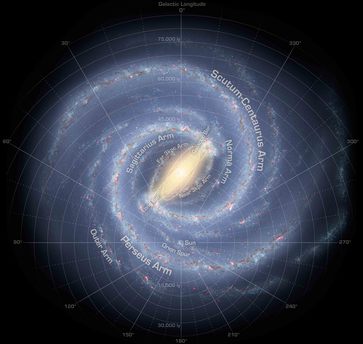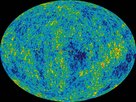Speed is relative
How fast is the Earth moving?
 © NASA/JPL-Caltech
|
An illustration of the Milky Way based on photographs taken by the Spitzer space telescope. It shows our Sun in the side arm called 'Orion Spur', below the light-colored center of the galaxy. The abbreviation 'ly' provides the distance in light years.
In addition, we must bear in mind that the Earth is simultaneously moving in different ways. It rotates around its polar axis, it orbits the Sun, it moves within the Milky Way as a part of the Solar System and it moves through the Universe as part of the Milky Way.
The larger the linear scales observed, the greater the Earth's speed.The turning of the Earth around its axis, the Earth's rotation, means that a point on the equator is traveling at a speed of around 1,000 miles per hour, or 1,500 feet per second. The Earth already has a speed of almost 20 miles per second on its path around the Sun.
It becomes even faster when we observe our galaxy, the Milky Way. The Sun is located around 25,000 light years (one light year equals about 5,865 billion miles) from the center of the Milky Way and needs approximately 240 million years for one orbit. The Sun and the Earth, which move with it as part of the Solar System, have a speed of 140 miles per second.
On the basis of measurements, scientists have deduced that the various speed components of our Solar System, which have different directions and therefore partly cancel each other out, add up to about 230 miles per second. The Milky Way and its neighboring galaxies form the so-called Local Group. A speed of around 390 miles per second has been calculated for this galaxy cluster. The speeds listed here cannot simply be added up to arrive at an overall speed, however, due to the fact that they refer to movements in different directions.
DLR
Speed is relative
How fast is the Earth moving?
 © NASA/JPL-Caltech
|
An illustration of the Milky Way based on photographs taken by the Spitzer space telescope. It shows our Sun in the side arm called 'Orion Spur', below the light-colored center of the galaxy. The abbreviation 'ly' provides the distance in light years.
In addition, we must bear in mind that the Earth is simultaneously moving in different ways. It rotates around its polar axis, it orbits the Sun, it moves within the Milky Way as a part of the Solar System and it moves through the Universe as part of the Milky Way.
The larger the linear scales observed, the greater the Earth's speed.The turning of the Earth around its axis, the Earth's rotation, means that a point on the equator is traveling at a speed of around 1,000 miles per hour, or 1,500 feet per second. The Earth already has a speed of almost 20 miles per second on its path around the Sun.
It becomes even faster when we observe our galaxy, the Milky Way. The Sun is located around 25,000 light years (one light year equals about 5,865 billion miles) from the center of the Milky Way and needs approximately 240 million years for one orbit. The Sun and the Earth, which move with it as part of the Solar System, have a speed of 140 miles per second.
On the basis of measurements, scientists have deduced that the various speed components of our Solar System, which have different directions and therefore partly cancel each other out, add up to about 230 miles per second. The Milky Way and its neighboring galaxies form the so-called Local Group. A speed of around 390 miles per second has been calculated for this galaxy cluster. The speeds listed here cannot simply be added up to arrive at an overall speed, however, due to the fact that they refer to movements in different directions.
DLR









